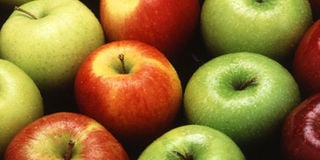Ugandans prefer imported to the locally grown apples

Apples are one of the fruits that have always been on the market, no matter the season or weather.
But although it is like that, the prices and the size of the fruits will keep changing from time to time whenever one goes to the market or on the streets to buy apples, but why is that the situation?
Ms Rose Atieno, a fruits trader in Nakasero Market, notes that the cost of apples is determined by the prevailing exchange rate for the US dollar.
Price and size
“The price at which I purchase the apples is always determined by the people who supply the fruits to the whole market. They buy according to the day’s rate and sell to us depending on how much they spent,” she says.
To her, it is not only the dollar rate that determines the prices but also the season. Usually, prices go down when the season is on and hiked when it is off.
“In most cases when the season is on, the apples on the market are big and at a cheaper price but will start seeing the smaller fruits at a high cost when the season is over,” she says.
Standard package
Ms Atieno adds that the bigger the apples, the less the number parked in the box and the smaller the size, the higher the number though they all have to measure up 18 kilogrammes.
When the apple season is on in South Africa where they are imported from, the price here will go as low as Shs95,000 to Shs130,000 a box of 120 to 150 fruits.
However, the supply will still be on when season is off but at a higher cost. A box will cost from Shs130,000 to Shs160,000 depending on the number of apples in the box.
Ms Atieno sells a kilo at Shs7,000 when the purchase price is low and Shs9,000 when the prices go up.
Traders refer to Ugandan apples as “golden” as a way of differentiating them from the imported ones.
The different types
The ones from outside the country are categorised in five different types.
These include: Arianna, which has a yellow and pink colour; Royal Gala, which is red with cream stripes; Pink Lady, which has a pinkish colour; Crispy-Pink, which has a green and pink colour; and Top Red, which has a dark red or maroon colour plus the green one that is mostly seen on the streets and taxi parks in Kampala.
Local apples
Although the fruit, which is mostly grown in temperate climates, has been thriving in Uganda since being introduced in Kabale District in 1999, traders who deal in apples say locally grown apple do not attract the Ugandan market.
“I once tried dealing in the Ugandan apples but things didn’t go well, my customers said that the apples had a weird taste. The other thing is that they are not attractive as the imported ones and they spoil very fast,” says Diana Mugambe, who is a trader in Nakasero Market.
The traders’ reaction about the apples grown in Uganda shows that there is a lot of efforts needed to improve on the quality of those produced in the country so that it can match with the imported ones. Most traders say they incur a lot of losses whenever they try to support the Ugandan apple farmers.




